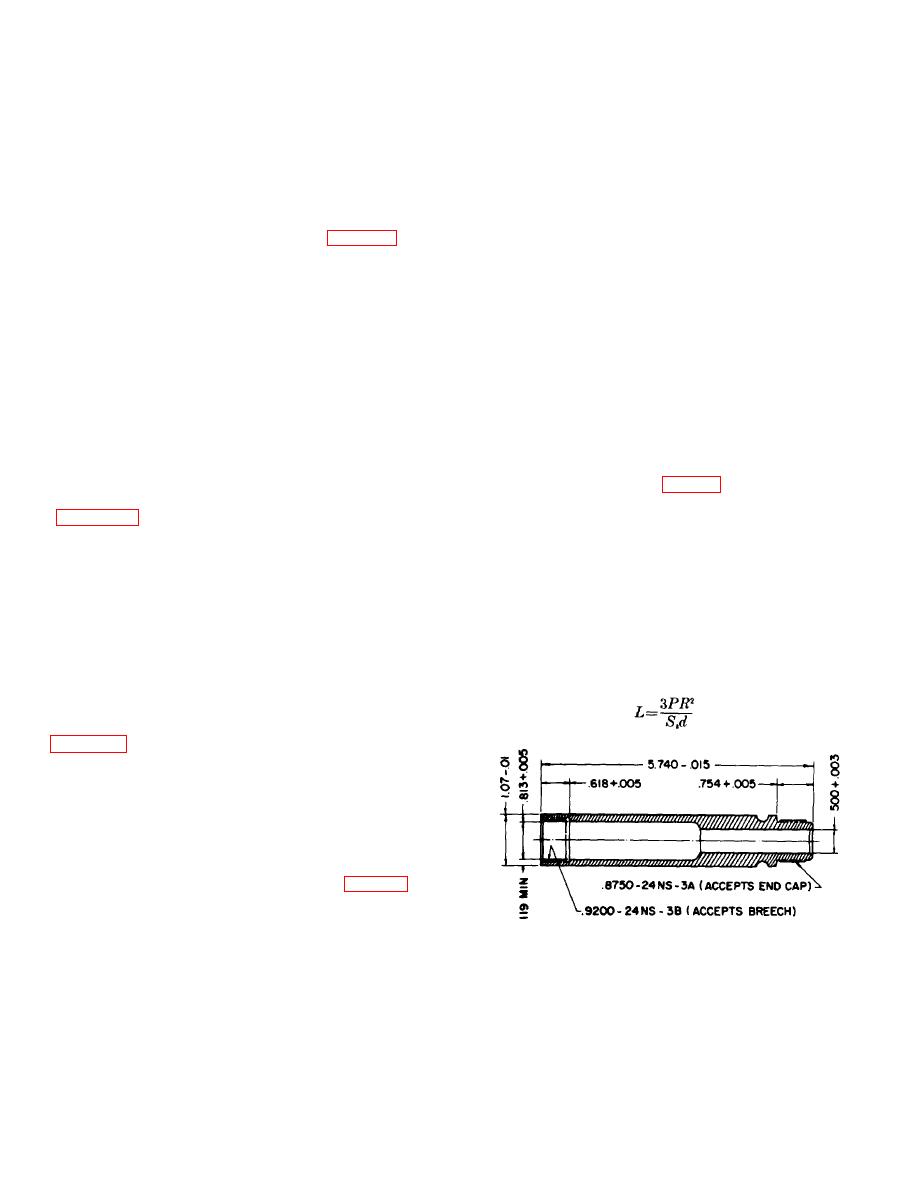
(The actual pressure should be at least twice this, to
c. The cartridge case selected for this application
allow for such effects as temperature and friction.) The
is 0.550 inch in diameter; however, the body of the
volume swept by the moving piston is 0.20 X 1.5 or 0.30
thruster cannot be made with an inside diameter small
cubic inch. The initial free volume of the cylinder,
enough to house the cartridge properly and still maintain
taking into account the cartridge retainer, etc., is 0.98
the specified outside diameter without adding
cubic inch. The total final interior volume of the thruster
appreciably to the weight of the assembly. Equally
is then 1.28 cubic inches.
important, if the inside diameter of the thruster was
d. Since the thruster must also supply bypass gas,
made small enough for proper housing of the cartridge,
the initial volume of the device would be decreased and
the charge weight is calculated in two parts. The
the expansion ratio would be increased. For these
minimum charge for thrust is found from figure 22 to be
reasons, the inside diameter of the thruster body is
0.25 gram (550-pound load, lifted 1.5 inches). The
made as large as possible. A cartridge retainer, similar
charge required for bypass can be calculated from
to the type used in initiators, is employed to prevent
equation (51) with suitable interpretation of Pt The
plugging of the bypass port and to prevent shatter of
required pressure at the end of 4 feet of hose is 1,000
propellant at -65F. This retainer fits snugly around the
psi; however, turbulent, high-velocity flow at the bypass
cartridge. The breech is threaded into internal threads
tube entrance will cause loss of pressure to about 70
in the cartridge retainer to hold the cartridge and
percent of the theoretical value, i.e., 1,000 psi is 70
cartridge retainer in place in the assembly. Four slots
percent of Pt. From equation (51), the required charge
are machined in the walls of the cartridge retainer.
is found to be about 1 gram. The total charge, for thrust
These slots permit the walls of the cartridge to rupture
and bypass, then, is approximately 1.25 grams.
and allow the propellant gas to escape while retaining
e. Assume that the ballistician will use H8
the propellant grain in the cartridge.
propellant for the workhorse studies. H8 is suitably
slow-burning, and one grain has adequate size (7/8-inch
long, with 3/8-inch O.D.) to fit the chamber and weight
(2 grams) to approximate the charge. Equation (57)
external threads on one end for assembly to the end cap
and internal threads on the other end for assembly to
opening of the bypass port. Using the 2-gram charge
the breech. The body houses the cartridge at the
5
and 1.28-cubic inch chamber volume, with 3.1 x 10 ft-
breech end and houses part of the piston at the other
lb/lb impetus and a B1 value of .45, the chamber
end. The remainder of the piston is housed in the end
pressure, Pt, is about 5,700 psi. Thus, it satisfies the
sleeve.
requirement for a pressure twice the minimum.
b. The maximum pressure which the threaded
(The value of B1 was chosen near the minimum
area (between the end cap and the body) will withstand
because the thruster is small, and the work done
is calculated by using equation (11).
represents only about one-fifth the total charge
(It is assumed that the body will be made of 705T6
requirement.)
aluminum.)
74. Cartridge. a. The cartridge consists of a case
containing the propellant, igniter, primer, and head.
standard cartridge cases is 0.550 inch. This case size is
satisfactory because the igniter will be placed in the
main propellant chamber along with the grain.
(Separate igniter chambers are seldom used with small
cartridges.) The cartridge case selected has a chamber
length of 1 inch.
b. A 72M percussion-type primer is selected for
use with the igniter in the cartridge. (See table IX for
data on this primer.)
Figure 68. Body of thruster.
85


